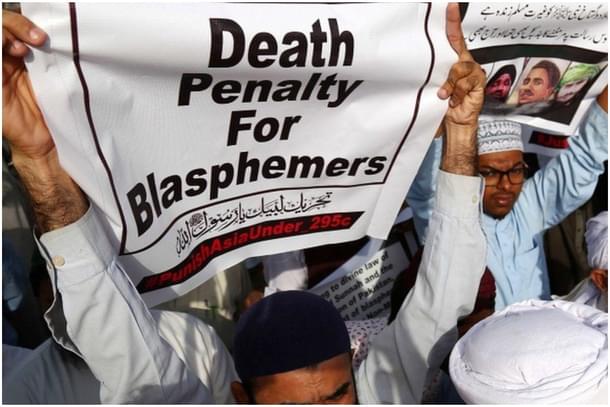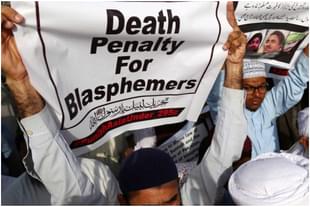News Brief
A Short History Of Shia Persecution In Pakistan
Swarajya Staff
Nov 13, 2021, 05:15 PM | Updated 05:15 PM IST
Save & read from anywhere!
Bookmark stories for easy access on any device or the Swarajya app.


Regardless of whether Ali actually follows Shiite Islam, the events brought to fore the plight of the Shia Muslim minorities in Pakistan, which constitute 15 to 20 percent of the total population of 212 million.
In the country, Sunni hardliner groups often organise anti-Shia rallies. As expected, the rhetoric justifying the Shia persecution is filled with the comparison with kafirs and polytheists. The three prominent groups within Sunni Islam — Deobandi, Sufi Barelvis and Salafists— often call the Shia sect “heretical,” its followers “infidels” and demand violent action against it.
The Shia sect differs from the Sunni on the validity of the successors of Muhammad, the prophet of Islam. Shias reject the first three caliphs — Abu Bakr, Umar ibn al-Khattab and Uthman ibn Affan. Instead, they believe Ali ibn Abi Talib, Muhammad’s cousin, was the rightful successor but was deprived of the caliphate; and Fatima, the daughter of prophet Muhammad, was denied her father’s inheritance by the first caliph, Abu Bakr.
The hardliners take Shia disassociation from the first three caliphs as unacceptable and blasphemous — making them subject to same violence as the non-Muslim minorities. Two hardline Sunni Muslim groups, Ahl-e-Sunnat-Wal-Jamaat (ASWJ) and Tehreek-e-Labbaik Pakistan (TLP) in Pakistan are at the forefront of anti-Shia campaign. The Sunni extremist groups are reportedly backed by the Imran Khan-led government.
Shia activists say that roughly more than 22,000 Shias have been killed since 1968 in the country.
Pakistan's draconian law on blasphemy
Last year, on 30 August in Karachi during the main Muharram procession, an elderly Shia man, Taqi Jaffer, was arrested for reciting Ziarat-e-Ashura, an important salutatory prayer in the Shia doctrine denouncing the killers of Hussein. Similarly, Shia orator Asif Raza Alvi was arrested for "hurting religious feelings" for talking about how the daughter of Prophet Muhammad, Fatima, was denied her father’s inheritance by the first caliph, Abu Bakr, in a private meeting in Karachi.
The draconian blasphemy law which also includes death penalty is routinely used against Shias for expressing their religious views. Just in one month last year, over 50 Shia Muslims were booked under blasphemy and antiterrorist charges in Pakistan- the youngest accused being three years old. In Punjab, the police beat up and arrested 22 Shia Muslims, including seven women, for taking part in a ceremony for a Shia martyr.
Powerful Sunni groups backed by state machinery
Deobandis have a long history of takfir- declaring Shias as apostate, a crime punishable by death in Islamic religious law. They formed Sipha-e-Sahaba (SSP) in the 1980s with the help of Pakistani military and Saudi Arabia’s funding to terrorize Shias through use of violence and coercion.
They see Shias as Iran’s fifth column and an obstacle in making Pakistan truly the “land of the pure” as Shias are the greatest “infidels”. In the 1990s, a splinter group, Laskar-e-Jhangvi (LeJ), emerged from SSP. Parallel with SSP, LeJ was involved in the killing of thousands of Shias across Pakistan. To counter these two militant groups, a private Shia militia, Sipah-e-Muhammad, was formed in 1994, allegedly with the backing of Iran.
Barelvis, who constitute the majority in Pakistan, with the help of the Pakistani military, take on the minority groups like Shias, Christians and the Ahmadiyya, particularly under the platform of the Tehreek-e-Labbaik Pakistan (TLP) party. Different groups in Pakistan compete over violence against the religious minorities, as a way to get recognition as the true and most worthy saviour of the Islamic faith. The radicalisation of the Barelvis against Shias is relatively new, and is blamed on the political engineering by the Pakistani establishment. The hardline Sunni groups enjoy patronage from state and military officials, who use their support for political gain.
In 2017, TLP forced a law minister to quit over a perceived softening in the blasphemy laws. Then, in the 2018 election, ASWJ and TLP were allowed to run in the election, winning seats in parliament. In the same election, ASWJ backed 70 candidates from Imran Khan’s Pakistan Tehreek-e-Insaf (PTI) party, which won and formed the government. The Pakistani government has allowed the TLP and ASWJ to assemble, make public anti-Shia speeches, carry out rallies, run for political office and mobilise against the Shia community.
Vigilantism
Demands have been rising in the country to constitutionally declare Shias as “non-Muslims” just like the Ahmadiyya. Last year, the Punjab government passed controversial Tahafuz-e-Bunyad-Islam (protecting the foundation of Islam) Bill to impose Sunni views on Shias. There are also demands to ban the recitation of Ziarat-e-Ashura which condemns the killers of Hussain; and Muharram processions.
Shias are killed in different parts of Pakistan, their religious congregations are attacked. In August this year during the Ashoura festival, a powerful roadside bomb exploded among a procession of Shia Muslims in central Pakistan, killing at least three and wounding over 50 people.
Common people would harass Shias on the street, forcing them to accept the Sunni version of history. The social media is flooded with videos in which Shias were forced to accept the Sunni historical account on the caliphs. The congregations of Shias are attacked, including, with stone pelting. Anti-Shia hashtags periodically trend- #گستاخِ_صحابہ_آزادکیوں (why is the blasphemer of companion free?) and #کافر_کافر_شیعہ_کافر (infidel, infidel, Shias are infidel). Once a person has been branded a 'kafir', and their photos shared on the social media, they along with their families are forced to go into hiding because of the threat of being killed by the mob.




